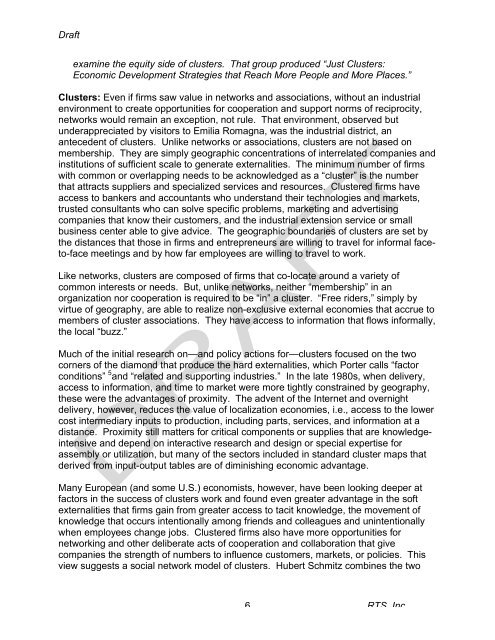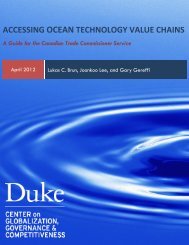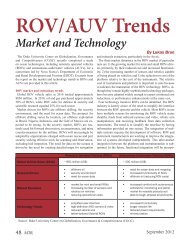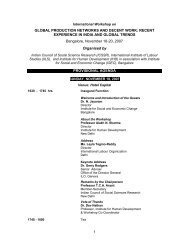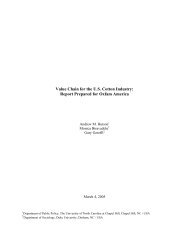Paper - Center on Globalization, Governance & Competitiveness
Paper - Center on Globalization, Governance & Competitiveness
Paper - Center on Globalization, Governance & Competitiveness
You also want an ePaper? Increase the reach of your titles
YUMPU automatically turns print PDFs into web optimized ePapers that Google loves.
Draft<br />
examine the equity side of clusters. That group produced “Just Clusters:<br />
Ec<strong>on</strong>omic Development Strategies that Reach More People and More Places.”<br />
Clusters: Even if firms saw value in networks and associati<strong>on</strong>s, without an industrial<br />
envir<strong>on</strong>ment to create opportunities for cooperati<strong>on</strong> and support norms of reciprocity,<br />
networks would remain an excepti<strong>on</strong>, not rule. That envir<strong>on</strong>ment, observed but<br />
underappreciated by visitors to Emilia Romagna, was the industrial district, an<br />
antecedent of clusters. Unlike networks or associati<strong>on</strong>s, clusters are not based <strong>on</strong><br />
membership. They are simply geographic c<strong>on</strong>centrati<strong>on</strong>s of interrelated companies and<br />
instituti<strong>on</strong>s of sufficient scale to generate externalities. The minimum number of firms<br />
with comm<strong>on</strong> or overlapping needs to be acknowledged as a “cluster” is the number<br />
that attracts suppliers and specialized services and resources. Clustered firms have<br />
access to bankers and accountants who understand their technologies and markets,<br />
trusted c<strong>on</strong>sultants who can solve specific problems, marketing and advertising<br />
companies that know their customers, and the industrial extensi<strong>on</strong> service or small<br />
business center able to give advice. The geographic boundaries of clusters are set by<br />
the distances that those in firms and entrepreneurs are willing to travel for informal faceto-face<br />
meetings and by how far employees are willing to travel to work.<br />
Like networks, clusters are composed of firms that co-locate around a variety of<br />
comm<strong>on</strong> interests or needs. But, unlike networks, neither “membership” in an<br />
organizati<strong>on</strong> nor cooperati<strong>on</strong> is required to be “in” a cluster. “Free riders,” simply by<br />
virtue of geography, are able to realize n<strong>on</strong>-exclusive external ec<strong>on</strong>omies that accrue to<br />
members of cluster associati<strong>on</strong>s. They have access to informati<strong>on</strong> that flows informally,<br />
the local “buzz.”<br />
Much of the initial research <strong>on</strong>—and policy acti<strong>on</strong>s for—clusters focused <strong>on</strong> the two<br />
corners of the diam<strong>on</strong>d that produce the hard externalities, which Porter calls “factor<br />
c<strong>on</strong>diti<strong>on</strong>s” 5 and “related and supporting industries.” In the late 1980s, when delivery,<br />
access to informati<strong>on</strong>, and time to market were more tightly c<strong>on</strong>strained by geography,<br />
these were the advantages of proximity. The advent of the Internet and overnight<br />
delivery, however, reduces the value of localizati<strong>on</strong> ec<strong>on</strong>omies, i.e., access to the lower<br />
cost intermediary inputs to producti<strong>on</strong>, including parts, services, and informati<strong>on</strong> at a<br />
distance. Proximity still matters for critical comp<strong>on</strong>ents or supplies that are knowledgeintensive<br />
and depend <strong>on</strong> interactive research and design or special expertise for<br />
assembly or utilizati<strong>on</strong>, but many of the sectors included in standard cluster maps that<br />
derived from input-output tables are of diminishing ec<strong>on</strong>omic advantage.<br />
Many European (and some U.S.) ec<strong>on</strong>omists, however, have been looking deeper at<br />
factors in the success of clusters work and found even greater advantage in the soft<br />
externalities that firms gain from greater access to tacit knowledge, the movement of<br />
knowledge that occurs intenti<strong>on</strong>ally am<strong>on</strong>g friends and colleagues and unintenti<strong>on</strong>ally<br />
when employees change jobs. Clustered firms also have more opportunities for<br />
networking and other deliberate acts of cooperati<strong>on</strong> and collaborati<strong>on</strong> that give<br />
companies the strength of numbers to influence customers, markets, or policies. This<br />
view suggests a social network model of clusters. Hubert Schmitz combines the two<br />
6<br />
RTS, Inc.


